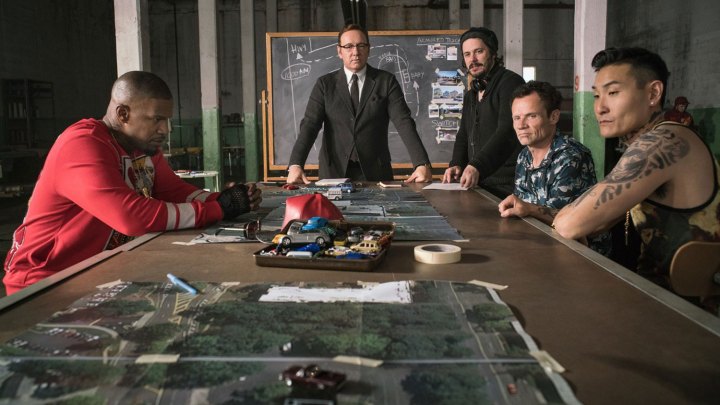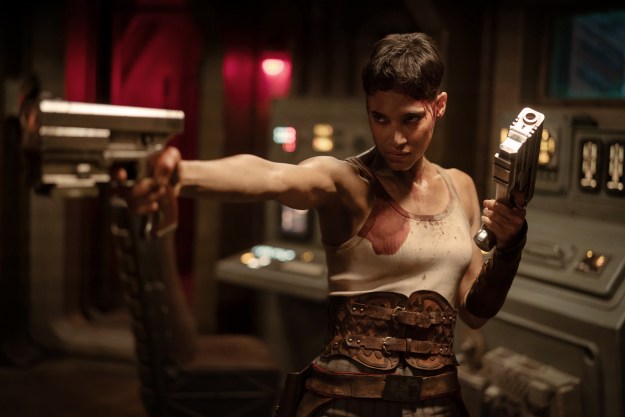
Written and directed by Wright, Baby Driver cast The Fault in Our Stars actor Ansel Elgort as “Baby,” a supremely skilled getaway driver who depends on a steady stream of music in order to counteract the effects of tinnitus. When he finds himself on the run after a botched robbery, he has to find a way to protect the people he loves while evading both cops and killers.
The task of crafting the blend of music, action, and sound effects that makes Baby Driver unlike any other movie in recent years fell to a team led by Julian Slater, a two-time Emmy nominee whose work on last year’s Mad Max: Fury Road was honored by the Motion Picture Sound Editors with a “Golden Reel” award.

Slater, who served as the film’s re-recording mixer, sound designer, and supervising sound editor, recently spoke with Digital Trends about the complicated process of making musical movie magic and bringing Wright’s vision for the film to life both on the screen and in the ears of the film’s audience.
Digital Trends: Did Baby Driver feel like something special when you were first introduced to the project?
Julian Slater: It totally did. It came in waves, really. I’ve been lucky enough to work with Edgar a few times, and every time I know that what is coming down the track toward me will be something I’ll be very proud of. He’s the kind of director who thinks about sound very early on in the process — more so on Baby Driver. When he pitched me the original idea [for the movie], that got the goosebumps going. And then when I got to read the script and realized just how Edgar was envisioning this movie, and what sort of central character the sound of the movie is, I spent months relishing the thought of working on it.
Did the experience of working on it live up to those expectations?
I’m lucky to have a great crew who worked with me on it, and there would frequently be times we’d be sitting down reviewing the work we’d done and we would be so excited and buzzed about what we were doing. We genuinely felt like this was something that had never been done before. To get to work on a movie that is very original and unique in itself, and then to be able to use the craft of what you do in such a unique way, that’s sort of a once-in-a-career thing. It doesn’t happen often. It was unique on so many layers.
Each time I watch Baby Driver, I catch something new in the way the music or other sound elements are synchronized with what’s happening on the screen. How complicated was the process of blending all of these elements?
The truth of the matter is that we had to work out how to do it. There was no roadmap for doing something like this. … If you just take the synchronization of the sound effects to the music, that in itself is quite a complex thing to do. People in the sound community normally work in timecode, but for this we had to switch over and work in bars and beats. So every song in the movie was what we call “tempo-mapped,” where you map out the tempo to any given point in the music.

For example, there’s the Hocus Pocus track playing when [Baby] is involved in a foot chase. The tempo of that track is not a constant thing. It’s not a “1, 2, 3, 4, 1, 2, 3, 4…” thing. It varies … All the police sirens are mapped to that tempo, so they need to be in sync at any given time to that music. That’s great to try and make the sirens sound kind of musical, but you also have to pitch-correct them to make the sirens sound musical based on that tempo — but when the tempo speeds up, the sirens sound crazy.
All the police sirens are mapped to the music, so they need to be in sync at any given time.
So then, when we listened to the sounds in the mix, we had to figure out when they work musically and cinematically. They have to tick all these checkboxes. Do the sounds work musically? Cinematically? Are they believable? Do they work fluidly with the music?
So it was a constant trial and error of putting things in, pitch-correcting them to the music, time-stretching them to make them fit, mapping them to the tempo of that particular point, then having a listen to it and occasionally deciding that it didn’t work because it sounded too musical or not musical enough, or it didn’t sound realistic. Then you take the sound out and try a new sound and go through the whole process again. We had to do that throughout the whole movie, trying so many things.
The sirens are part of that, and so are the gunshots and even the gear-shifting sounds. How deeply did you go into the sounds of the film with all of this synchronization?
Well, I’m glad you keep noticing new things, because one thing we desperately wanted to do was to make it a multilayered experience. We didn’t want it to be something you watched once and heard everything that’s in sync. We wanted to be cleverer than that, and we didn’t want the viewer to get frustrated or tired of that mechanism. Half an hour into it, we didn’t want the audience to be like, “We get it, okay? You synchronized the music.” Let’s just say there are so many things in there subtly as well as overtly that you’ll catch each time you go through the movie.
Was the cast aware of how big a role music was going to play in the film, structuring their performances accordingly, or was it a simply a matter of making the music fit what they gave Edgar?
Edgar sort of wrote the script around each song.
They were very much aware. Edgar sort of wrote the script around each song. It wasn’t a case of him writing the script and then coming up with the music choices. With the first draft of the script, he had the music choices buttoned down, and [the licenses] cleared well in advance of the shoot.
When he pitched it to each individual actor, he released the script in an iPad app. When you turned each page, it played the relevant piece of music. Everyone knew at the very beginning exactly which piece of music was relevant to each scene. Beyond that, every actor either had an earpiece in their ear playing the music, so they could walk or sometimes talk and act in sync with the soundtrack, or they’d have it playing across speakers on the set so everyone could hear it. So it was always in the DNA of the movie.
Movies often don’t get licenses for particular music until shooting is underway or even afterward. How did all of this forethought by Edgar affect your approach to the film?
To be a little selfish about it, it made my job a little easier. If you’ve got a six-minute chase sequence on foot around Hocus Pocus and every piece of sound effect is choreographed to work with that music cue, and then that music cue is switched out due to some licensing issue, you’re kind of screwed. But we had the luxury of knowing that wouldn’t be the case.
Soundtracks are such a big part of movies lately. Baby Driver is a great example, but songs were big in the Guardians of the Galaxy movies and so many others. What’s your perspective on this trend?

I think what has happened recently is that people are returning to music from a different decade. Baby Driver, sort of like Guardians of the Galaxy, has music that isn’t just from one particular decade. It has songs from the ’50s, ’60s, ’70s, and ’80s, and so on. And I’m all for that. Personally, anything that helps tell a good story or makes for a better soundtrack, I’m all for it.
You also worked on Mad Max: Fury Road, which had such amazing sound. That movie and Baby Driver both relied heavily on the car-chase palette of sounds, with engines roaring and gears shifting and such. Does that kind of story and environment present any unique challenges? Is it a fun sandbox to play in, sound-wise?
It’s interesting that you compare Mad Max and Baby Driver, because to me they are so different. Mad Max dealt with a dystopian post-apocalyptic future where all the cars were these crazy inventions, whereas in Baby Driver the cars were extremely normal. Edgar didn’t want the cars to be this Fast and Furious kind of style, where the cars are all suped-up. He did a lot of research and spent time talking to former bank robbers, and they said they would jack a car an hour before the bank job so that it wasn’t hot yet. They would be very normal cars, so that they didn’t stick out. My challenge was to make them sound exciting and cool.
But in Mad Max, we could make the cars crazy-looking and crazy-sounding. So the two movies, although both had vehicles, were very different in approaches.
What went into making those normal cars sound more exciting?
You might not notice this, but in Baby Driver the different car chases even sound different. The first car chase is the perfect chase, with everything going according to plan. So in that car chase, we have all these wonderful “whooshes” and everything is tuned perfectly to the music. Later on when things go awry, we detuned the sound a bit and some of the cars’ sounds aren’t quite so stylized. As we go through the movie and things start crashing down around Baby, the sounds start getting a bit more detuned to the music to reflect what’s happening with him.
It feels like a testament to your efforts that, in the rare occasions when there’s no music, the movie actually feels a bit strange. There’s definitely a void that you feel as a member of the audience.
That is definitely deliberate. The device we came up with was, when Baby is not listening to his music through earbuds or music isn’t playing through his environment, like in the diner, we have the tinnitus sound. That sound changes depending on the environment. Sometimes it’s a high-pitched whistle, sometimes it’s held strings in the score. And the more stress Baby is feeling, the louder the tinnitus. Sometimes it’s subtle, and sometimes it’s in your face. That tinnitus effect was designed to put you on edge. That’s an important story point, after all.
Really, the whole point of what we were trying to do was to play the sound aspect from Baby’s point of view. When he puts his earbuds on and you’re listening to the music he’s listening to, it’s all around you. It’s much more heavy. And when he takes his right earbud out, we played the music on the left side of the theater — sometimes throughout the whole scene, which is unconventional, but we wanted to play it as Baby’s music.




